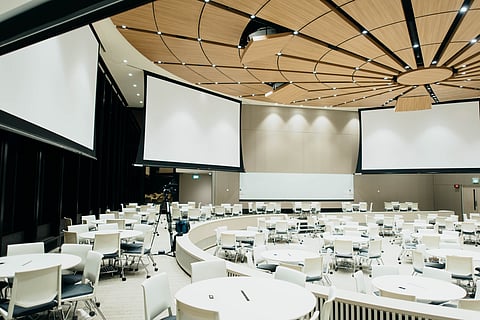
- Home
- न्यूजग्राम
- NewsGram USA
- India
- World
- Politics
- Entertainment
- Culture
- Lifestyle
- Economy
- Sports
- Sp. Coverage
- Misc.
- NewsGram Exclusive
- Jobs / Internships

By Cameron
Introduction
In the modern business landscape, effective communication and collaboration are essential for success. Meetings and conferences play a crucial role in facilitating such interactions. To optimize the productivity and comfort of these gatherings, conference table chairs have undergone significant evolution over the years.
From basic seating arrangements to ergonomically designed marvels, these chairs now focus on enhancing efficiency, promoting health, and creating a conducive environment for creativity and innovation. This article explores the evolution of conference table chairs and the various features that make them indispensable components of a successful meeting culture.
1. Early Days: The Origins of Conference Table Chairs
The concept of conference tables can be traced back to ancient civilizations, where rulers and leaders would gather around tables to discuss important matters. In these early days, chairs were primarily wooden and rigid, often adorned with intricate designs to signify power and authority. Comfort was not a priority, and long meetings could be taxing for participants.
2. The Transition to Modern Design
As societies evolved, so did the design of conference table chairs. During the Industrial Revolution, advancements in manufacturing processes allowed for the mass production of furniture, leading to more accessible and affordable options. Chairs began to feature padding and upholstery, which improved comfort during extended meetings.
3. The Rise of Ergonomics
In the latter half of the 20th century, the importance of ergonomics in workplace design gained recognition. Ergonomic principles were applied to conference table chairs to promote healthier posture and reduce the risk of musculoskeletal issues. Adjustable seat heights, lumbar support, and armrests became standard features, allowing users to customize their seating position for optimal comfort.
4. Technology Integration
As technology infiltrated the modern workplace, conference table chairs adapted to accommodate these advancements. Chairs now come equipped with cable management solutions, power outlets, and integrated charging ports. This integration enables seamless connectivity for devices during meetings, eliminating clutter and improving efficiency.
5. Sustainable Materials and Environmental Responsibility
With an increased emphasis on sustainability and environmental responsibility, many manufacturers now use eco-friendly materials in the production of conference table chairs. Recycled plastics, responsibly sourced wood, and low-emission upholstery are some examples of how the industry is evolving to reduce its carbon footprint.
6. Aesthetics and Customization
Conference table chairs are no longer just functional; they also serve as elements of office aesthetics. Companies are recognizing the importance of creating an inviting and professional atmosphere in meeting rooms. As a result, chairs are available in a wide range of designs, colors, and finishes, allowing businesses to match their office décor and brand identity.
7. Collaboration and Mobility
In recent years, the trend of collaborative workspaces has become increasingly popular. This shift has influenced the conference table design, with an emphasis on mobility and flexibility. Many modern chairs are lightweight and equipped with wheels, allowing easy movement and rearrangement to adapt to different meeting formats.
8. Health and Well-being
Sedentary lifestyles and prolonged sitting have raised concerns about the health implications of office work. In response, conference table chairs now incorporate features like active sitting mechanisms, which promote micro-movements during prolonged sitting, reducing the risk of health issues related to inactivity.
9. Virtual and Hybrid Meetings
In recent times, the way we conduct business and communicate has undergone a dramatic transformation, largely driven by advancements in technology and changing work dynamics. Two innovative meeting formats that have gained widespread popularity are Virtual Meetings and Hybrid Meetings.
Virtual Meetings, also known as online meetings or web conferences, are entirely conducted in a digital environment. Participants join from their respective locations using video conferencing tools, enabling seamless collaboration across borders and time zones. This format has become a cornerstone of remote work, allowing teams to maintain productivity while reducing travel costs and the carbon footprint.
Conclusion
The evolution of conference table chairs reflects the changing dynamics of the modern workplace. From rigid and uncomfortable seating arrangements to ergonomically designed, technology-integrated, and environmentally responsible chairs, the focus has shifted to enhancing productivity, collaboration, and well-being.
As businesses continue to embrace innovation and adapt to evolving work cultures, conference table chairs will remain essential tools in creating a conducive environment for effective communication and collaboration. By recognizing the importance of investing in high-quality, thoughtfully designed chairs, organizations can foster a meeting culture that maximizes productivity and nurtures the creativity and innovation necessary for success in the competitive global market.
